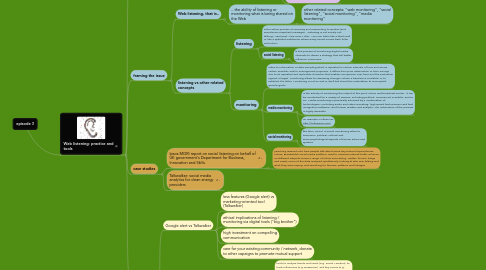
1. Web listening: practice and tools
1.1. how to implement web listening?
1.1.1. media intelligence tools (several and diverse)
1.1.1.1. SocialMention
1.1.1.2. Augure: presentation (in IT)
1.1.1.2.1. webzie feature = automated press review of publications (e.g. posts, tweets) on social media; articles from traditional media can also be included
1.1.1.3. BuzzSumo
1.1.1.3.1. useful to find influencers
1.1.1.4. Mention
1.1.1.5. Radian6
1.1.1.5.1. allow an easy export of raw data, hence used in academic and independent research (e.g. in USA)
1.1.1.5.2. more
1.2. framing the issue
1.2.1. Web listening, that is..
1.2.1.1. ...the ability of listening or monitoring what is being shared on the Web
1.2.1.1.1. other related concepts: "web monitoring", "social listening", "social monitoring", "media monitoring"
1.2.2. listening vs other related concepts
1.2.2.1. listening
1.2.2.1.1. is the active process of receiving and responding to spoken (and sometimes unspoken) messages. "Listening is not merely not talking," said poet Alice Duer Miller. "You can listen like a blank wall or like a splendid auditorium where every sound comes back fuller and richer"
1.2.2.1.2. social listening
1.2.2.2. monitoring
1.2.2.2.1. refers to information or data sampling which is repeated in certain intervals of time and serves certain scientific and/or management purposes. It differs from pure observation or from surveys due to its repeated and replicable character that enables comparison over time and the evaluation against a target. Monitoring allows for assessing changes, where a baseline is available, or to establish the latter. Monitoring is not an end in itself but should be undertaken to accomplish specific goals
1.2.2.2.2. media monitoring
1.2.2.2.3. social monitoring
1.3. case studies
1.3.1. Ipsos MORI report on social listening on behalf of UK government's Department for Business, Innovation and Skills
1.3.1.1. year-long research into how people talk about some key science topics/stories online; Brandwatch social media platform used to measure internet traffic volumes on different subjects across a range of online sources(e.g. Twitter, forums, blogs and news); some of the data analysed qualitatively, looking at who was talking and what they were saying, and searching for themes, patterns and linkages
1.3.2. Talkwalker: social media analytics for clean energy providers
1.4. reflections
1.4.1. Google alert vs Talkwalker
1.4.1.1. less features (Google alert) vs marketing-oriented tool (Talkwalker)
1.4.1.2. ethical implications of listening / monitoring via digital tools ("big brother")
1.4.1.3. high investment on compelling communication
1.4.1.4. care for your existing community / network, donate to other capaigns to promote mutual support
1.4.2. UK government recommendations for civil servants about best practices and tools to monitor e.g. what is being said about policies on social media and online news sites
1.4.2.1. tools to analyse trends and reach (e.g. Social Mention), to track influencers (e.g. Buzzsumo) and key voices (e.g. Crowdvoice), to analyse large scale social media data (e.g. Radian6)
1.4.2.2. citizen journalism: CrowdVoice
1.4.2.2.1. supported by Omidyar Network and Shuttleworth Foundation
1.4.2.2.2. tracks voices of protest by curating and contextualising data
1.4.2.2.3. presentation

